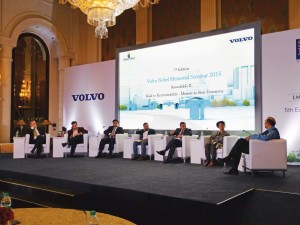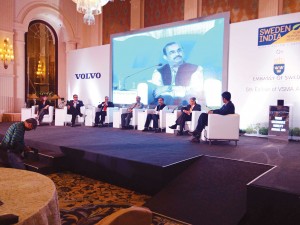Honouring efforts in the direction of sustainable mobility, Volvo pointed at a sustainable electromobile future.
Story by:
Anirudh Raheja
In an effort to felicitate outstanding contribution in the area of sustainable mobility, Volvo Buses India organised the fifth edition of Volvo Sustainable Mobility awards in New Delhi. Through the exercise, which dates back to a decade of successful journey, Volvo Buses honoured initiatives in traffic management, cloud based technology, road safety, and BRT systems that aim to develop public transport as an attractive transportation medium. With a prime objective of developing and deploying cloud based software system that facilitates efficient management of public bus operations, Mapunity, a Bengaluru based technology firm was adjudged the winner for its ‘Buscloud’ project. The award included a cash prize of Rs.12 lakhs. The Centre of Green Mobility in partnership with Ahmedabad Traffic Police received the first runner up award for their initiative tagged ‘The Crosswalk Lab’. This project aims to increase pedestrian safety and improve traffic management especially at the traffic junctions in a city. Advocacy against drunken driving’ project by ArriveSAFE was awarded for spreading awareness towards reducing the fatalities that happen due to the consumption of poppy, a popular drug for commercial vehicle drivers to stay awake during long journeys. ArriveSAFE has been actively working towards enhancing road safety. “It is all about the urgency with which all stakeholders are contributing to make cities better. And, it is not just about the solutions and ideas being presented,” said VRV Sriprasad, MD, Volvo Buses India.
For a sterling effort, the jury also gave special recognition to Rainbow BRT, Pune, and Atal Indore City Transport Services (AICTSL), which has been a joint initiative of Pune Mahanagar Parivahan Mahamandal Ltd., Pune Municipal Corporation, Pimpri-Chinchwad Municipal Corporation and Institute for transportation and Development Policy. The project has been aiming to regulate city bus riding across Pune and Indore through Mass Rapid Transit system and offer safe, reliable public transport and reduce private vehicle usage for daily commute. Volvo Buses also honoured IBUS BRTS, an initiative of Atal Indore City Transport Services, for their unique effort to cater to over one lakh passengers every day with just 100 city buses in Indore. The company also put the spotlight on its initiative, Engage. Volvo Engage is an effort to catalyse partnerships across various areas for sustainable mobility according to sources at Volvo Buses. Since road and vehicle safety program is a very disintegrated effort in India, through Volvo Engage, Volvo Buses is trying to assimilate various stakeholders to bridge the gap between what exists and what needs to be done.
The first of the two round table discussions held at the event focused on making the Indian roads safer for all (pedestrians and vehicles). With the market dynamics in India deferring from those in the developed countries, it was unanimously agreed upon by the panelists that building awareness and forming a public opinion for proactive adoption of safety measures along with the road safety bill is necessary. Mentioned Rajeev Lochan, Director, Road Safety, Ministry of Road Transport and Highways, “There has to be a bill which is a true piece of legislation and has better acceptance across all sections of the society. It is also important to convey and implement that good Samaritans who will help on the road will not get into trouble while helping accident victims.” Lochan mentioned that urban congestion and poor infrastructure can’t be dealt with overnight, the need is to find little measures that can reduce road fatalities. Mentioned a panelist that everything cannot be done at the legislative level. Another panelist expressed that even at a micro level the collaborative efforts could bring about a significant change. Sunil Chaturvedi, CEO, Automotive Skill Development Corporation, averred, “Skilled drivers and technicians are required in a big number. Drivers should drive and technicians should carry out repairs. The role of the two cannot be mixed. Leaving the two to do what they most like will help towards reducing accidents. The same could be done by issuing certificates from training schools.” Piyush Tiwari, Founder and CEO, Save Life Foundation, said, “At a micro level, education has never had a measurable impact on road safety. The techniques of safety are fine but need to be enforced effectively. Effective enforcement is tough, and the only way it could be achieved is through technology. There is a need to combine education, assessment and enforcement.”
The second panel discussion was on electromobility. One of the participants drew attention to the dangerous levels of pollution attained at Delhi. He added that there was a need for alternate propulsion mediums in the country. Stated a panelist that they have been witnessing a steady rise. Another panelist said that the need to was to curb pollution. It will be impossible without taking private vehicles off the road and enforce public transport for daily commute, he added. Anumita Roy Chowdhary, Director, Centre for Science and Environment (CSE), said that Delhi is already running short of choices. There is an urgent need to enforce radical measures like robust public transport along with quick escalation to BS IV and BS V emission norms, she added. She also stressed upon the need to introduce electric technologies that can address the impact of vehicular emissions in India. Mentioned VG Ramakrishnan, MD—South Asia, Frost & Sullivan, “Providing incentives for the uptake of electric vehicles can play a crucial role but it is very important to implement a technologically neutral fuel, and not just blindly implement anything like how the Delhi government did for CNG without understanding the basics of the propulsion medium.” For a country like India, where coal is a big source of making electricity, curbing pollution is not as simple. Akash Passey, Senior VP, Business Region International, Volvo Buses, averred, “If you have buses that are creating pollution, it is spread across the city. When you are moving to electric buses, the power plant has its own regulations and treatment solutions before the smoke is given out and then it is centralized which means that you have emissions centralized at one place which is probably outside the city.”
Vehicular emissions have been one of the biggest contributors for the air quality levels in Delhi to have deteriorated. The air quality is expected to get worse. More than 1.5 lakh road fatalities happen every year on Indian roads. If the trends continue, the figure can go up to 2.25 lakh by the year 2025. The need is to look beyond regulations, and the compelling need is to follow the rules. A significant change will get underway when all the stakeholders come together in a purposeful passion to attain sustainable mobility in India.



























